As we approach 2024, the silver market is poised for significant shifts. FintechZoom, a leading financial technology platform, has identified 10 key trends that could shape silver prices in the coming year. These insights are crucial for investors, traders, and industry professionals looking to stay ahead in the precious metals market.
From global economic factors to technological advancements, the silver market is influenced by a complex web of variables. Understanding these trends can help you make informed decisions and potentially capitalize on market movements. Whether you’re a seasoned investor or just starting to explore the world of precious metals, these insights from FintechZoom offer valuable guidance for navigating the silver market in 2024.
Key Takeaways
- FintechZoom identifies 10 key trends shaping silver prices in 2024, influenced by global economic factors and technological advancements
- Industrial demand for silver is expected to surge in 2024, driven by electronics, automotive, 5G technology, and the green energy sector
- Digital trading platforms and silver ETFs are gaining popularity, offering increased accessibility and investment opportunities
- Silver mining production is forecast to increase by 3% in 2024, while recycling efforts are projected to grow by 7%
- Experts predict silver prices to range between $24 and $30 per ounce in 2024, with potential for 15% price appreciation
Understanding Silver Price Dynamics on FintechZoom
Factors Influencing Silver Prices
Silver prices fluctuate based on several key factors. Supply and demand dynamics play a crucial role, with industrial applications accounting for over 50% of silver consumption. Economic indicators, such as GDP growth and manufacturing output, directly impact industrial demand. Currency fluctuations, particularly the US dollar’s strength, inversely affect silver prices. Geopolitical events and monetary policies also influence investor sentiment and silver’s appeal as a safe-haven asset.
FintechZoom’s Silver Price Analysis Tools
FintechZoom offers comprehensive tools for analyzing silver price trends. Real-time price charts provide minute-by-minute updates, allowing you to track intraday movements. Technical analysis indicators, such as moving averages and relative strength index (RSI), help identify potential entry and exit points. FintechZoom’s silver price forecasting models incorporate machine learning algorithms to predict future price movements based on historical data and current market conditions.
Interpreting Silver Price Charts on FintechZoom
Reading silver price charts on FintechZoom requires understanding key elements. Candlestick patterns reveal short-term price momentum and potential reversals. Support and resistance levels indicate price points where buying or selling pressure may increase. Volume indicators show trading activity, helping confirm trend strength. FintechZoom’s interactive charts allow you to customize timeframes and overlay multiple indicators for in-depth analysis.
Silver Price Correlations with Other Assets
FintechZoom’s data reveals significant correlations between silver prices and other assets. Gold and silver prices often move in tandem, with a correlation coefficient of 0.8 over the past decade. Silver’s industrial uses create a positive correlation with copper prices, reflecting global economic health. Inverse relationships exist with the US dollar index and real interest rates, as lower rates increase the attractiveness of non-yielding assets like silver.
Market Sentiment Analysis on FintechZoom
FintechZoom incorporates market sentiment indicators in its silver price analysis. Social media sentiment trackers gauge investor mood through keyword analysis of platforms like Twitter and Reddit. Options market data, such as put-call ratios, provide insights into trader expectations. FintechZoom’s proprietary sentiment index combines these factors to offer a comprehensive view of market psychology surrounding silver prices.
Global Economic Factors Influencing Silver Prices

Global economic factors play a crucial role in shaping silver prices on FintechZoom. These factors create a complex interplay of market forces that impact silver’s value in the global marketplace.
Inflation and Monetary Policy
Inflation rates and central bank monetary policies significantly influence silver prices. As inflation rises, investors often turn to precious metals like silver as a hedge against currency devaluation. The Federal Reserve’s interest rate decisions directly affect silver’s attractiveness as an investment:
- Low interest rates: Reduce the opportunity cost of holding non-yielding assets like silver, potentially increasing demand
- High interest rates: Make interest-bearing investments more appealing, potentially decreasing silver demand
Central banks’ quantitative easing programs can lead to increased money supply, potentially driving up silver prices as investors seek alternative stores of value.
Geopolitical Tensions
Geopolitical events and tensions create uncertainty in financial markets, often boosting silver prices:
- Trade disputes: Escalating trade wars between major economies can lead to currency fluctuations and increased silver demand
- Political instability: Unrest in key silver-producing regions can disrupt supply chains, potentially driving up prices
- Sanctions: Economic sanctions against countries with significant silver production can impact global supply and demand dynamics
During periods of heightened geopolitical tension, investors typically flock to safe-haven assets like silver, causing price spikes. FintechZoom’s analysis tools help track these global events and their potential impact on silver prices, providing valuable insights for investors navigating the volatile precious metals market.
Industrial Demand for Silver in 2024
Industrial demand for silver is poised to increase significantly in 2024, driven by technological advancements and the growing green energy sector. This surge in demand is likely to impact silver prices on FintechZoom and other financial platforms.
Technological Advancements Driving Demand
Technological advancements are fueling the industrial demand for silver in 2024. The precious metal’s unique properties make it essential in various high-tech applications:
- Electronics: Silver’s excellent conductivity makes it crucial in smartphones, tablets, and laptops.
- Automotive industry: Electric vehicles require more silver for battery management systems and charging infrastructure.
- 5G technology: The rollout of 5G networks increases silver usage in antennas and base stations.
- Internet of Things (IoT): Smart devices and sensors incorporate silver in their components.
- Medical technology: Silver’s antimicrobial properties make it valuable in medical devices and equipment.
These innovations are expected to boost silver consumption by 15% in the electronics sector alone, according to industry analysts.
Green Energy Sector’s Impact
The green energy sector is a major driver of industrial silver demand in 2024:
- Solar panels: Photovoltaic cells use silver paste for conductivity, with each panel containing about 20 grams of silver.
- Wind turbines: Silver is used in electrical control systems and bearings.
- Energy storage: Silver-zinc batteries are gaining popularity as an alternative to lithium-ion batteries.
The International Energy Agency projects a 25% increase in renewable energy capacity in 2024, directly correlating with higher silver demand. This growth in the green energy sector is likely to influence silver prices on FintechZoom and other financial platforms as investors monitor industrial consumption trends.
Investment Trends in Silver Markets
Silver markets continue to evolve, with new investment trends emerging in 2024. These trends reflect changing investor preferences and technological advancements in the financial sector.
Digital Silver Trading Platforms
Digital platforms have revolutionized silver trading, making it more accessible to a wider range of investors. FintechZoom’s analysis tools provide real-time data and insights for silver price trends. These platforms offer:
- 24/7 trading opportunities
- Lower transaction costs compared to traditional methods
- Advanced charting and analysis tools
- Mobile accessibility for on-the-go trading
- Integration with other financial instruments
The adoption of blockchain technology in some platforms enhances transparency and security in silver transactions. This trend is expected to grow by 30% in 2024, attracting tech-savvy investors to the silver market.
Silver ETFs and Futures
Silver Exchange-Traded Funds (ETFs) and futures contracts remain popular investment vehicles in 2024. These financial instruments offer:
- Exposure to silver prices without physical ownership
- Increased liquidity compared to physical silver
- Diversification options for investment portfolios
- Potential for leveraged returns through futures contracts
Silver ETF assets under management are projected to increase by 20% in 2024, driven by investor demand for precious metals as a hedge against economic uncertainty. Futures contracts provide opportunities for both hedging and speculation, with trading volumes expected to rise by 15% on major exchanges.
Supply-Side Considerations for Silver
Silver supply dynamics play a crucial role in shaping market prices. Mining production and recycling efforts significantly impact the overall availability of silver in the market.
Mining Production Forecasts
Global silver mine production is expected to increase by 3% in 2024. Key silver-producing countries like Mexico, Peru, and China are ramping up their mining operations to meet growing industrial demand. New technological advancements in mining techniques are improving extraction efficiency, potentially leading to a 5% increase in output from existing mines. However, geopolitical tensions in some silver-rich regions may disrupt production schedules, causing temporary supply constraints.
Recycling and Secondary Supply
Recycling efforts are becoming increasingly important in the silver market. The secondary silver supply is projected to grow by 7% in 2024, driven by improved recycling technologies and heightened environmental awareness. Electronic waste recycling is a major contributor, with an estimated 15% of global silver supply coming from e-waste recovery. Industrial scrap recycling is also on the rise, with a 10% increase expected in the coming year. These recycling trends are helping to offset potential shortfalls in primary mining production and stabilize silver prices on FintechZoom.
Silver Price Forecasts for 2024
Silver price forecasts for 2024 indicate a dynamic market with potential for growth. Experts and analysts provide insights into the expected trends and factors influencing silver prices in the coming year.
Expert Predictions and Analysis
Financial analysts project silver prices to range between $24 and $30 per ounce in 2024. The World Bank’s Commodity Outlook report anticipates a 5% increase in silver prices due to rising industrial demand. Investment banks, including Goldman Sachs and JP Morgan, predict silver outperforming gold with a potential 15% price appreciation.
Precious metals specialists cite several factors supporting bullish forecasts:
- Increased industrial demand from renewable energy sectors
- Ongoing global economic uncertainty driving safe-haven investments
- Potential supply constraints from major silver-producing countries
- Continued growth in silver-backed ETF holdings
Analysts caution that geopolitical tensions and central bank policies remain key variables affecting price volatility. FintechZoom’s expert panel emphasizes monitoring these factors for accurate silver price predictions in 2024.
Risks and Opportunities in the Silver Market
Market Volatility and Price Fluctuations
Silver prices experience significant volatility, with price swings of 5-10% in a single day not uncommon. These fluctuations create both risks and opportunities for investors. Sharp price drops can lead to substantial losses, while sudden spikes offer potential for quick gains. To navigate this volatility, investors use technical analysis tools on platforms like FintechZoom to identify trends and make informed decisions.
Geopolitical Tensions and Economic Uncertainty
Geopolitical events and economic instability significantly impact silver prices. Trade disputes between major economies can disrupt supply chains, affecting industrial demand for silver. Economic downturns often drive investors towards precious metals as safe-haven assets, potentially increasing silver prices. Monitoring global news and economic indicators is crucial for anticipating market shifts.
Industrial Demand Shifts
Silver’s industrial applications in electronics, solar panels, and medical devices create unique market dynamics. Technological advancements can suddenly increase demand, as seen with the 20% growth in silver use for photovoltaic cells in 2023. Conversely, new technologies or material substitutions can reduce demand in certain sectors. Staying informed about industrial trends is essential for predicting silver market movements.
Investment Demand and ETF Flows
Silver-backed ETFs significantly influence market prices. In 2023, silver ETF holdings increased by 15%, contributing to a 10% rise in silver prices. However, large-scale ETF outflows can lead to rapid price declines. Investors should monitor ETF flow data on financial platforms to gauge market sentiment and potential price impacts.
Mining Production and Supply Constraints
Silver mining production affects market supply and prices. Labor strikes, environmental regulations, or natural disasters can disrupt mining operations, potentially leading to supply shortages and price increases. For example, a major strike in Peru, the world’s second-largest silver producer, reduced global supply by 4% in 2022, causing a temporary 8% price spike.
Monetary Policy and Interest Rates
Central bank decisions on interest rates and monetary policy influence silver prices. Lower interest rates typically support higher silver prices by reducing the opportunity cost of holding non-yielding assets. Investors should pay attention to Federal Reserve announcements and global monetary trends to anticipate potential impacts on silver prices.
Technological Advancements in Trading
Digital silver trading platforms and blockchain technology are revolutionizing market access and transparency. These advancements offer opportunities for more efficient trading and reduced transaction costs. However, they also introduce new risks, such as cybersecurity threats and market manipulation through high-frequency trading algorithms.
Environmental Regulations and Sustainable Mining
Increasing focus on sustainable mining practices and environmental regulations presents both challenges and opportunities in the silver market. Stricter regulations may increase production costs, potentially leading to higher silver prices. Conversely, companies adopting sustainable practices may gain competitive advantages and attract environmentally conscious investors.
Silver vs. Other Precious Metals: Comparative Outlook
Silver’s performance in 2024 stands out when compared to other precious metals, offering unique characteristics that appeal to investors and industries alike. Gold, platinum, and palladium each present distinct market dynamics, but silver’s dual role as both an industrial metal and a store of value sets it apart.
Silver and Gold: The Classic Duo
Silver and gold often move in tandem, but with key differences:
- Price volatility: Silver experiences greater price fluctuations
- Industrial demand: Silver has more extensive industrial applications
- Investment accessibility: Silver’s lower price point attracts a broader range of investors
In 2024, silver’s price-to-gold ratio remains a crucial indicator for investors, with historical averages suggesting potential for silver to outperform gold if the ratio narrows.
Silver vs. Platinum: Industrial Competitors
Silver and platinum compete in various industrial applications:
- Automotive sector: Platinum dominates in catalytic converters
- Electronics: Silver leads due to its superior conductivity
- Price dynamics: Silver offers cost advantages in many applications
As green technologies advance, both metals see increased demand, but silver’s broader industrial use provides a competitive edge in 2024.
Palladium and Silver: Niche Markets
Palladium and silver serve distinct market segments:
- Automotive focus: Palladium primarily used in gasoline engine catalysts
- Diverse applications: Silver spans multiple industries
- Supply considerations: Both face potential supply constraints
While palladium remains crucial for automotive emissions control, silver’s versatility in emerging technologies positions it favorably for 2024.
Investment Considerations
Investors weigh several factors when comparing precious metals:
| Factor | Silver | Gold | Platinum | Palladium |
|---|---|---|---|---|
| Volatility | High | Moderate | Moderate | High |
| Industrial Demand | High | Low | Moderate | High |
| Investment Demand | Moderate | High | Low | Low |
| Supply Outlook | Tight | Stable | Tight | Tight |
Silver’s unique position offers both growth potential and risk, making it an attractive option for diversified precious metal portfolios in 2024.
Conclusion
As you navigate the complex world of precious metals investing in 2024, silver stands out as a dynamic and multifaceted option. Its unique blend of industrial utility and investment appeal offers intriguing opportunities. While market volatility persists, silver’s potential for growth makes it an attractive consideration for your diversified portfolio. Stay informed about global economic trends, technological advancements, and geopolitical factors to make well-informed decisions. Remember, like any investment, silver carries risks, but its distinctive characteristics could position it favorably in the evolving financial landscape of 2024 and beyond.
Frequently Asked Questions
What are the main factors influencing silver prices in 2024?
Key factors affecting silver prices in 2024 include global economic conditions, geopolitical tensions, industrial demand, emerging investment trends, and technological advancements. Supply-side considerations, monetary policies, and the performance of other precious metals also play significant roles in shaping silver’s market value.
How does silver compare to other precious metals as an investment?
Silver offers unique characteristics compared to gold, platinum, and palladium. It has wider industrial applications than gold, making it more sensitive to economic cycles. Silver is more accessible to small investors due to its lower price point. However, it can be more volatile than gold, presenting both higher potential returns and risks.
What is the price-to-gold ratio, and why is it important?
The price-to-gold ratio compares the prices of silver and gold. It’s an important metric for investors as it helps gauge the relative value of silver. When the ratio is high, silver may be undervalued compared to gold, potentially signaling a buying opportunity. Conversely, a low ratio might indicate silver is overvalued relative to gold.
How do industrial applications affect silver prices?
Industrial demand significantly impacts silver prices due to its widespread use in electronics, solar panels, and other technologies. Changes in industrial consumption can cause price fluctuations. As new technologies emerge or existing ones evolve, the demand for silver in industrial applications can shift, influencing its market value.
What role do ETFs and futures contracts play in the silver market?
Silver ETFs and futures contracts provide investors with exposure to silver prices without physically owning the metal. These financial instruments can increase market liquidity and accessibility. Their popularity can influence silver prices, as large inflows or outflows from these products can affect market demand and supply dynamics.
How might geopolitical tensions impact silver prices in 2024?
Geopolitical tensions can significantly affect silver prices by influencing global economic stability, currency values, and investor sentiment. During times of political uncertainty, investors may turn to precious metals like silver as safe-haven assets, potentially driving up prices. Conversely, easing tensions might reduce demand for silver as a hedge.
What are the potential risks of investing in silver?
Investing in silver carries risks such as price volatility, sensitivity to economic cycles, and potential oversupply. Changes in industrial demand or shifts in investor sentiment can lead to rapid price fluctuations. Additionally, silver’s lower liquidity compared to gold can result in wider bid-ask spreads, especially during market stress.
How does technological advancement affect the silver market?
Technological advancements impact the silver market in two main ways. First, they can create new industrial applications, potentially increasing demand. Second, innovations in trading platforms and blockchain technology are changing how investors access and trade silver, potentially affecting market dynamics and price discovery processes.








